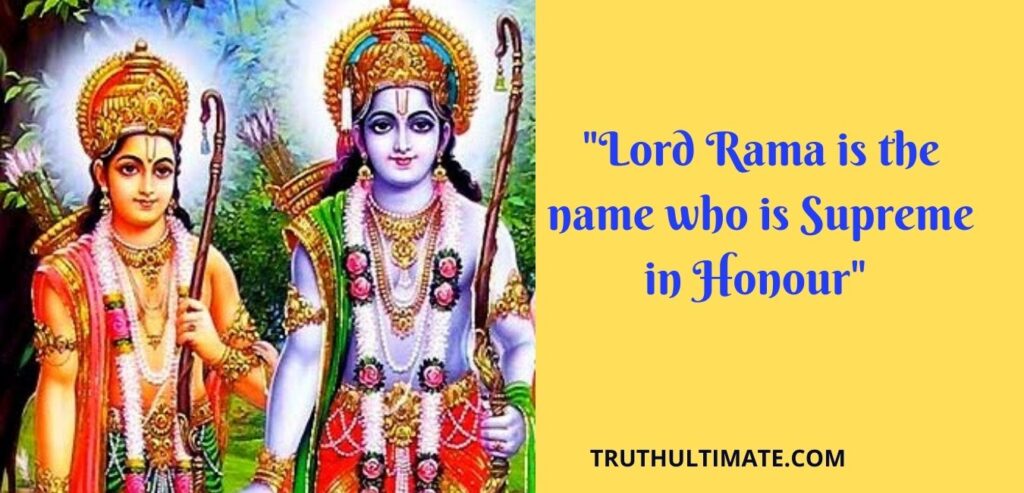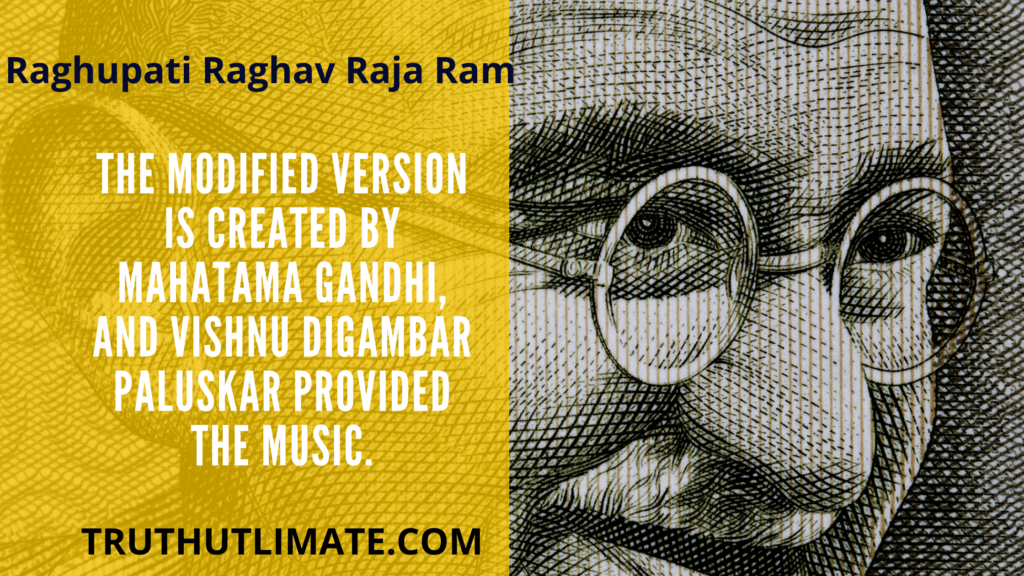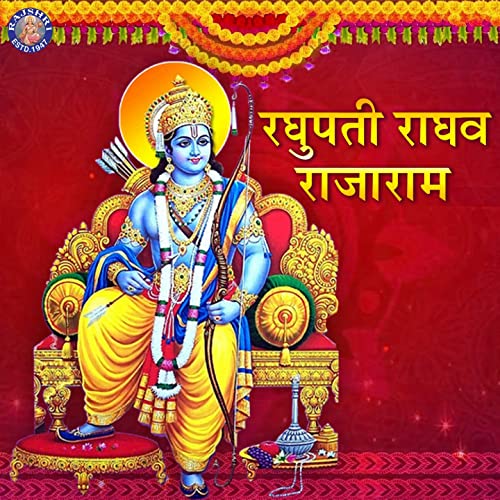Raghupati Raghav Raja Ram रघुपति राघव राजाराम (prominently called Ram Dhun) is a striking bhajan (Hindu reverential melody) broadly promoted by Mahatma Gandhi.

The most famous form of this Bhajan was set to tune by Hindustani traditional artist Pandit Vishnu Digambar Paluskar.
The Bhajan preaches secularism, which means it brings Hindu, Muslims, and Christians close.

This is an exceptionally famous reverential tune sung in India.
This melody was one of the top choices of Mahatma Gandhi and recited consistently in his supplication gatherings.
Raghupati Raghav Raja Ram Meaning
When you really associate with the Divine, you develop fortitude that gives you boldness, dauntlessness, certainty, and energy.

Raghupati Raghav Raja Ram has an extremely incredible impact. In addition to the fact that it becomes positive karma.
It additionally gives us the solidarity to deal with issues, and it assists us with confiding in the Divine. These aides us in the accomplishment of a definitive objective of life.
What is a definitive objective? To acknowledge God as the Soul inside the sanctuary of our heart, and this is accomplished through supplication.
Along with positivity, it brings tolerance for others as well, which we need nowadays. The tolerance for other’s points of view, other’s religions, and casts.

The melody begins with the recognition of Raghupati Raghav Raja Ram (Lord Ram). Lord Ram is a manifestation of Vishnu (the saving part of Brahman).
Lord Ram is the epitome of Dharma (Right obligation, nobility) and Virtue.
Raghupati Raghav means one who has achieved all otherworldly information, is solid and firm in nobility, is brilliant like the thousand Suns, and has Viveka (profound separation) and Vairagya (dispassion for common thing). Such is Lord Ram.

Patit Pavan implies the uplifter of the individuals who have tumbled from the way of honorableness and prudence.
Thus, we call upon Mother Sita and Raja Ram, who are the uplifters of the fallen.
Mother Sita is the little daughter of Earth. She means magnanimous Love and Virtue.
Mother Earth offers us all that she has without asking anything as a trade-off.
Mother earth is consistently unadulterated, and all that we get comes from that immaculateness.
Bhaj Pyare Tu Sita Ram implies – O adored Lord Ram and Mother Sita, we acclaim you for what you are and what you connote.
Ishvar Allah Tero Naam implies – People call you by many names, some call you God “Ishvar” while some call you Allah.

Yet you are the unrivaled Brahman, limitless Divinity that is inside us all of us we are all inside you.
Sabko Sanmati De Bhagavan implies – Bless everybody with that we are on the whole the result of a similar matter and cognizance and that we all endeavor towards the way of nobility and ideals.
As we established, religious tolerance is necessary, and this Bhajan Raghupati Raghav Raja Ram is the epitome of religious tolerance and secularism.
Here is why it’s important. Creating and advancing standards of resilience is significant in the globalized world.
To upgrade social relations and forestall clashes, it is important to set up a ground for common agreement, arrangement, and resilience on the boundary of religions, dialects, and nationality.
No discoursed can be led in case there is no regard for common freedoms, law and order, majority rule standards, and profound qualities.
Mainstream philosophy as well as strict philosophy is an objective of life in the socially enhanced world.

On the planet, we are on today, every landmass, city, and the littlest town has a type of conviction set.
Strict conviction often has the effectiveness over social orders with religion’s capacity to form social laws, limits, and here and there hold whole influence over government frameworks.
At the point when strict convictions are combined with strict prejudice, and individuals are willing to follow up on that narrow-mindedness and strict convictions.
Today, it is generally seen that religion is effectively utilized as an apparatus in the political undertakings paying little heed to the mainstream framework.
There are two explanations behind the politicization of religion. First and foremost, it is considered as a fundamental interest for political, social, and individual needs.
Also, some old strict ceremonies are in clashes with a common philosophy.
Freedom of religion in India is a key right ensured by Article 25-28 of the Constitution of India.

Current India appeared in 1947 and the Indian constitution’s prelude was altered in 1976 to express that India is a secular state.
But, in modern times, we see religious tolerance decreasing day by day.
Strict resistance is significant because it assists us with regarding and like the distinctions in strict practices.
To set up worldwide harmony is to stay away from brutality and follow the ethics lectured by all religions.
Tolerance among religions and all individuals is a prerequisite to making a universe of harmony, love, and bliss.
Between strict discourse is imperative to accomplish a superior world. Indeed, even theists and skeptics should discover a method of comprehension.
A portrayal of harmony and love between all beings. Also, some old strict ceremonies are in clashes with a common philosophy.
All religion promotes peace and no one promotes violence. Maybe centuries ago you can get control with violence and arms.
Whereas, in this modern world, you can promote your religion only by your actions. Your true actions impress people.
Raghupati Raghav Raja Ram written by?
We discussed the melodious Bhajan with its meaning in detail, but who actually wrote that?
Basically, it’s an excerpt from the hymn ‘Sri Nama Ramayanam’, that Lakshmanacharya originally composed.
Although, the original lyrics differ from what’s practiced today.

The modified version is created by Mahatama Gandhi, and Vishnu Digambar Paluskar provided the music.
Moreover, it’s derived from Ramcharitmanas, written by Tulsidas.
Gandhi and Paluskar sang the popular melodious Bhajan along with their followers as they walked the 241 miles (387 km) Salt March to Dandi.
The father of the nation is adored across India for his goals and theory.
Mahatma Gandhi was known for bringing a conversion between reality and otherworldliness and music was without a doubt separated from it.
The combination of music, petitions, psalms with his political philosophies and gatherings has been archived.
A portion of the reverential tunes or bhajans related to him is ‘Vaishnav Jan to’ and ‘Raghupati Raghav Rajaram’.
We should comprehend the importance and brief history of this notable melody.

During the Dandi March, this was the tune that enlivened and lifted individuals’ spirits, it achieved that harmony among all Indians.
Music is that component that can achieve that expect all. Also, as this is Indian instrumental swadeshi music, it goes past the boundaries of language.
Raghupati Raghav raja ram real bhajan:
Here is the original version of the popular hymn Raghupati Raghav Raja Ram, which most of us are unaware of.
The Nama Ramayana composed by Shri Lakshmanacharya doesn’t contain the verse or sloka of “Raghupati Raghav Raja Ram”, and is very surprising yet different.
Sanskrit:
रघुपति राघव राजा राम ।
पतित पावन सीताराम ॥प॥
सुंदर विग्रह मेघश्याम
गंगा तुलसी शालग्राम
भद्रगिरीश्वर सीताराम
भक्तजनप्रिय सीताराम
जानकीरमण सीताराम
जयजय राघव सीताराम ॥१॥
जल में राम ताल में राम
सारे जग में तू हि राम
राम राम राम राम
प्रेम से बोलो जै सियाराम ॥२॥
कौसल्या के प्यारे राम
दशरथ राज दुलारे राम
प्रेम से बोलो जै सियाराम ॥३॥
जग में जो सो सुन्दर राम
सीता राम जै जै श्री हनुमान ॥४॥
Translation:
O King Raghava (Rama)! Chief of the Raghu dynasty, the descendant of King Raghu.
O the consort of Sita! The uplifter of those who have fallen.
You are dark-skinned and good-looking like rain clouds.
You are prayed in the form of Shalagram with Tulasi and Ganga water.
O the consort of Sita! You are the Lord of Bhadrachalam hill.
O the one dearest to the devotees!
O the loved one of Janaki!
Victory to you, the descendant of the Raghu dynasty and consort of Sita!
Ram is in water, Ram is on the shore,
Ram is everywhere in life.
From your heart, say “Jai Siya Ram”.
The darling of Kausalya,
the pet of King Dashratha.
From your heart, say “Jai Siya Ram”.
Sita and Ram are the two beautiful names in the world.
Victory to Shri Hanuman!
Raghupati Raghav Raja Ram Patit Pavan Sita Ram
रघुपति राघव राजाराम,
पतित पावन सीताराम
सीताराम सीताराम,
भज प्यारे तू सीताराम
ईश्वर अल्लाह तेरो नाम,
सब को सन्मति दे भगवान
राम रहीम करीम समान
हम सब है उनकी संतान
सब मिला मांगे यह वरदान
हमारा रहे मानव का ज्ञान
This is the modified version that we follow nowadays.

And, this is what Father of Nation made part of his prayers every day.
Let’s look at the translation and transliteration of the famous Bhajan.
Translation:
O Lord Rama, a descendant of Raghu, Uplifter of the fallen.
You and your beloved consort Sita are to be worshipped.
All names of God refer to the same Supreme Being,
including Ishvara and Allah.
O Lord, Please give peace and brotherhood to everyone,
as we are all your children.
We all request that this eternal wisdom of humankind prevail.
You may wonder what changes do Mahatama Gandhi made?
Mahatama Gandhi added Allah in the Bhajan to make the Bhajan more secular and promote peace and religious tolerance.
Raghupati Raghav Raja Ram Lyrics
The popular Bhajan has many modifications and is part of many songs until now.
Here are the lyrics of some songs that included the popular hymn of “Raghupati Raghav Raja Ram”.
- Movie Shri Ram Bhakta Hanuman (1948)
जय रघुनन्दन जय सियाराम,
जानकी वल्लभ सीताराम ।
दशरथ राजदुलारे राम,
कौशल्या के प्यारे राम,
भक्तों के रखवाले राम,
जग के पालनहारे राम ।
रघुपति राघव राजा राम,
पतित पावन सीताराम ॥
- “Ram Kirtan” Version:
रघुपति राघव राजा राम पतित पावन सीताराम ।
ईश्वर शिव तेरा नाम सबको सुमति दे भगवान ॥ रघु ०
जय रघुनन्दन जय सियाराम जानकी बल्लभ सीताराम ॥
कपिपति लंकापति अभिराम, जय मारुतसुत पुरण काम ॥
- A version from another excerpt:
रघुपति राघव राजा राम, पतित-पावन सीताराम ॥
सीताराम सीताराम, भज प्यारे तू सीताराम ॥
राम-कृष्ण हैं तेरे नाम । सब को सन्मति दे भगवान ॥
दीन-दयालु राजाराम, पतित-पावन सीताराम ॥
Raghupati Raghav Raja Ram Song
Once, Mahatama Gandhi modified the Bhajan; since then, it’s been an important part of the Indian Culture.
And, we have seen many versions of it, and that’s a good development because the beautiful lyrics and the harmonious rhythm make it one of a kind.
Not just the rhythm, but the lyrics give away a very good message of religious tolerance and praises Lord Rama bringing in spirituality and positivity in their lives.

- Components of the serenade were remembered for the melody:
“Utho he Bharat” in the film Bharat Milap (1942)
Tunes of Shri Ram Bhakta Hanuman (1948)
The tune “De Dii Hamen Aazaadii” in the film Jagriti (1954)
Purab Aur Paschim (1970)
Film Kuch Hota Hai (1998)
Kannada film Gandhinagara (1968)
British-Indian film Gandhi (1982)
Film “Gandhi, My Father (2007)”
Satyagraha (2013)
- Pete Seeger included “Raghupati Raghava Raja Ram” in his collection “Outsiders and Cousins” (1964) and performed it in Episode 10 of his TV series Rainbow Quest.
- Sheila Chandra recorded a form named Bhajan on her 1992 collection Weaving My Ancestors’ Voices.
- Numerous vocalists, for example, Lata Mangeshkar, Jagjit Singh, K.S.Chithra has recorded the melody.
- The game Grand Theft Auto: Liberty City Stories highlighted the melody on one of the radio broadcasts Radio Del Mundo.
- The melody is a significant theme in the 2006 Bollywood film Lage Raho Munna Bhai and is highlighted in the film.
- Rakesh Roshan’s superhuman film Krrish 3 contains a melody named “Raghupati Raghav”.

- The course of action by Jyotishka Dasgupta is an authority piece of Grade 2 Electronic Keyboard from Trinity College London, where it is essentially named Bhajan.
Conclusion
Bhajan alludes to any reverential melody with the strict subject or otherworldly thoughts, explicitly among Indian religions, in any of the dialects from the Indian subcontinent.

The term bhajanam (Sanskrit: भजनम्) implies love and starts from the root word bhaj, intends to venerate, as in “Baja govindam”.
The expression “bhajan” likewise implies sharing. The term ‘bhajan’ is additionally regularly used to allude to a gathering occasion.
With at least one lead vocalist went with the music, and now and again dancing.
Minimally there is a percussion backup, for example, tabla, a dholak, or tambourine.
Handheld little cymbals (kartals) are normally used to keep up with the beat, musicality.
As a bhajan has no recommended structure or set standards, it is in free structure, typically melodious and because of melodic ragas.
It has a place with a classification of music and expressions that were created with the Bhakti movement.
It is found in the different practices of Hinduism just as Jainism. Inside Hinduism, it is especially common in Vaishnavism.
Thoughts from sacred texts, unbelievable legends, the lessons of holy people, and adoring dedication to God are the regular subjects of bhajans.
South Indian bhakti pioneers, yet bhajans have been broadly formed secretly and shared as a melodic and expressions custom.
Its kind, for example, Nirguni, Gorakhanathi, Vallabhapanthi, Ashtachhap, Madhura-bhakti, and the conventional South Indian structure Sampradaya Bhajan each have their own collection and techniques for singing.
Thus, India has a wide collection of bhajans, and some of them are pretty popular as well and is on the tongues of people of every household.
Raghupati Raghav Raja Ram is one of them.
References:
https://en.wikipedia.org/wiki/Raghupati_Raghava_Raja_Ram
https://en.wikipedia.org/wiki/Raghupati_Raghava_Raja_Ram





